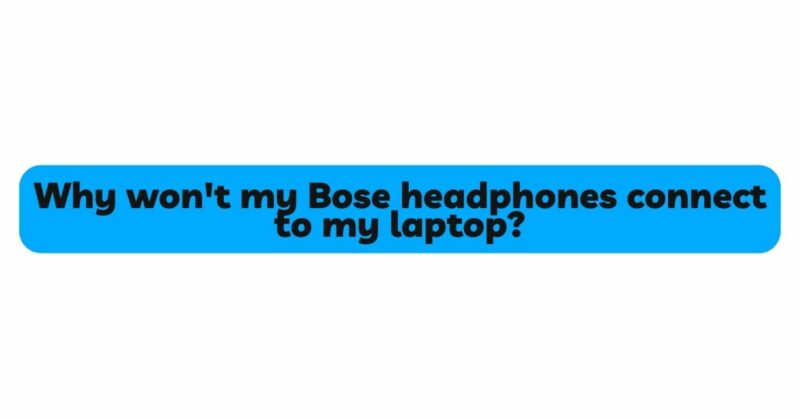In today’s fast-paced world, headphones have become an integral part of our lives, offering a sanctuary from the chaos of the outside world. Among the top contenders in the headphone market is Bose, renowned for their superior sound quality and innovative technology. However, even the best devices can sometimes encounter connectivity issues, leaving users frustrated and puzzled.
This article aims to delve into the reasons why Bose headphones might fail to connect to laptops and provide practical troubleshooting solutions. We will explore both hardware and software-related factors, allowing users to gain a better understanding of their headphones’ connectivity challenges and empowering them to resolve the issues efficiently.
I. Compatibility and Hardware Factors:
- Audio Jack and USB Connectivity: One of the most common issues that users face is trying to connect Bose headphones with traditional audio jacks or USB ports. While many modern laptops come with 3.5mm audio jacks, some newer models have started phasing them out in favor of USB-C ports, leading to compatibility problems. Users need to identify the type of audio port on their laptop and ensure that their Bose headphones are compatible.
- Bluetooth Version: Another crucial aspect to consider is the Bluetooth version. Bose headphones are typically designed to work seamlessly with most Bluetooth-enabled devices. However, outdated Bluetooth versions on some laptops may cause pairing problems. Users should check their laptop’s Bluetooth specifications and update the drivers to the latest version if required.
- Battery and Power Issues: Low battery levels on Bose headphones can hinder connectivity, leading to intermittent connections or outright failures. Similarly, laptops with low battery power might struggle to establish a stable connection with Bluetooth devices. Ensuring that both devices have ample power is essential for a smooth connection.
- Wireless Interference: Interference from other wireless devices can disrupt Bluetooth connections. Common culprits include Wi-Fi routers, cordless phones, and even other Bluetooth devices in close proximity. Relocating the laptop and headphones away from such interference sources can significantly improve connectivity.
II. Software and Driver Related Factors:
- Outdated Drivers: Like any other hardware peripheral, Bose headphones require drivers to communicate with the laptop’s operating system. Outdated or corrupted drivers can lead to connectivity issues. Users should regularly check for driver updates on both their laptops and the Bose website to ensure they are running the latest compatible versions.
- Bluetooth Settings: Misconfigured Bluetooth settings on the laptop might prevent Bose headphones from connecting. Users should verify that their laptop’s Bluetooth is turned on, set to discoverable mode, and ready to pair with new devices. Sometimes, simply toggling Bluetooth off and on can resolve minor connection problems.
- Device Pairing: Pairing is the process of establishing a connection between the laptop and the Bose headphones. Some users might mistakenly pair the headphones with another device and forget to disconnect them. Clearing the existing pairings and starting the pairing process anew can rectify this issue.
- Operating System Updates: Major operating system updates can occasionally introduce compatibility issues with certain peripherals, including headphones. In such cases, users should check for software patches or firmware updates from both Bose and the laptop manufacturer to address any compatibility glitches.
III. Environmental Factors:
- Range Limitations: Bluetooth connectivity operates within a certain range, typically around 30 feet. If the user moves too far away from the laptop while wearing the Bose headphones, the connection may weaken or break altogether. Staying within the recommended range can help maintain a stable connection.
- Signal Obstructions: Physical obstructions, such as walls, furniture, or other electronic devices, can weaken the Bluetooth signal between the laptop and headphones. Users should ensure a clear line of sight between the two devices or reduce the number of obstacles between them for better connectivity.
IV. Additional Troubleshooting Tips:
- Restarting Devices: Sometimes, a simple restart can fix connectivity issues. Power cycling the laptop and Bose headphones can refresh their settings and resolve temporary glitches.
- Resetting Headphones: Most Bose headphones come with a reset option that restores factory settings. If all else fails, performing a reset can often resolve deep-seated connectivity problems.
Conclusion:
In conclusion, connectivity issues between Bose headphones and laptops can be attributed to a variety of hardware, software, and environmental factors. By understanding these potential challenges and following the troubleshooting tips provided in this article, users can enjoy a seamless audio experience once again. Regularly updating drivers, maintaining optimal battery levels, and ensuring proper Bluetooth settings are essential for ensuring a trouble-free connection. Remember that each scenario may vary, and patience, along with trial and error, is sometimes necessary to pinpoint and resolve the specific issue causing the connectivity problem.


